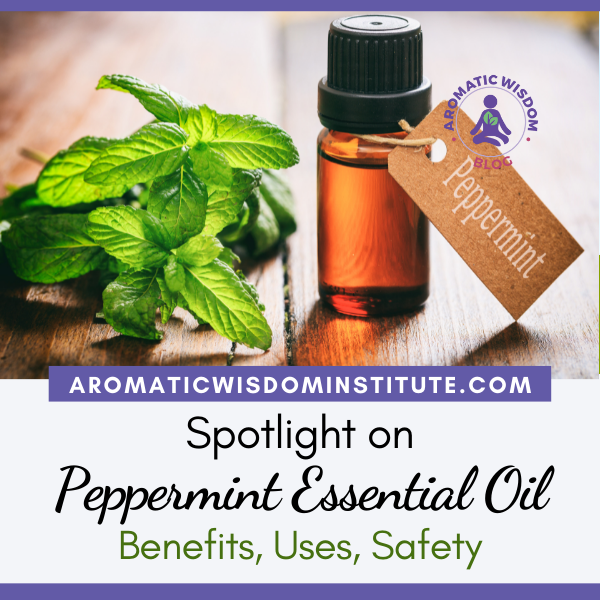Essential Oil of Peppermint
Mentha x piperita
The Greek god Pluto, ruler of the underworld, fell madly in love with a beautiful nymph, Mentha. His jealous wife, Persephone, pounded her into the earth. Pluto then turned poor Mentha into an aromatic plant that gave him consolation. I’m thinking Pluto’s passions must have abated after a time because today’s popular essential oil suggests cool reality rather than anything romantic.
My Personal Relationship with Peppermint
I never get tired of this old friend. Never. Peppermint’s piercing and a clean hit of fresh menthol are always welcome in my nostrils. I use this oil a lot in the massage room as clients tend to become congested after lying face-down on the table for 30 minutes or more. I’ll often put a drop on a tissue and tuck it in the face cradle. I learned the hard way that this oil is to be avoided on the body as clients will end up shivering from the cold. I do, however, use it generously on my feet.
This essential oil is also a family favorite in the car. One drop on a tissue stuffed in the air vent and you’ve got a minty ride. It keeps the driver awake and settles any nausea from passengers that feel car sick.
Geographical Sources: USA, India, Australia, France
Plant Part: Aerial (everything above ground)
Botanical Name: Whenever you find an “x” in the botanical name like Menta x piperita, it indicates that the plant is a hybrid and not an original species. Peppermint is a hybrid though the actual origin of it is confusing due to a large number of complex hybrids under cultivation. The general consensus seems to be that it is a cross between Spearmint (Mentha spicata) and Watermint (Mentha aquatica).
Other Species: There are several species of mint as you can see below. This demonstrates the importance of getting into the habit of knowing essential oil nomenclature.
Mentha x piperita: Peppermint
Mentha spicata: Spearmint
Mentha arvensis: Cornmint
Mentha aquatica: Watermint
Extraction: Steam distillation from the stem and leaves of the flowering herb. The plant is harvested at full bloom when it contains the maximum amount of essential oil.
Oil Characteristics: The essential oil of Peppermint is a pale yellow or greenish thin liquid with a highly penetrating, fresh, minty aroma.
Chemical Families: Monoterpenes, Monoterpenols
Therapeutic Properties of Peppermint Essential Oil
Increases alertness and energy levels
Supports digestion. It has an antispasmodic action on the colon. Do not ingest peppermint essential oil for digestion as the menthol content is too high. Instead, drink peppermint hydrosol or peppermint tea.
Some Suggested Applications for Using Peppermint Essential Oil
- Inhaler: 10 drops of Peppermint in a nasal inhaler is useful to carry in your purse or pocket for nasal congestion, headaches, nausea and motion sickness.
- Steam Inhalation: ONE drop of this essential oil in steam inhalation with Tea Tree essential oil is a valuable cold remedy.
- Headache: I love the combine Lavender and Peppermint for headache relief. A drop on the fingertips massaged into the neck feels great when you have a headache, especially when combined with Lavender essential oil. Keep in mind that Peppermint has a cooling effect on the skin as the nerve endings that perceive cold are stimulated and the blood capillaries contract, so remember not to go overboard.
- Cleaning: I frequently clean my kitchen counter with a Peppermint + Lemongrass blend and add it to my homemade soft scrubs. Peppermint smells fresh and clean and gives a sense of tidiness and order.
Peppermint Essential Oil Foot Scrub Recipe
Citrus Mint Foot Scrub
Subtle Properties of Peppermint Essential Oil (vibrational and energetic)
Solar Plexus Chakra: Peppermint resonates with this energy center to promote healthy self-esteem and integrity.
Throat Chakra: At this energy center, Peppermint promotes clarity in communication and concentration.
Third Eye Chakra: Peppermint stimulates conscious mind and promotes inspiration and insights.
Peppermint Affirmation: “I am awake and alert. My mind is clear and energized.”
Safety Information: Peppermint may be an antidote to homeopathic remedies. It is non-toxic but may cause skin irritation so use at 1% (5 drops: 1 oz carrier) Avoid using with children under 5 years; it is too strong. It may be more therapeutically effective in small doses. Menthol-rich oils should be avoided by people with clotting disorders.
Where to Buy Essential Oils?
I’m frequently asked what essential oil brand I like, so here are a few both with and without GC/MS reports available.
Essential Oil Suppliers with GC/MS reports
Essential Oil Suppliers without GC/MS reports (Affordable choices for cleaning or non-clinical use)






I have a one year old. Can spearmint be used instead of peppermint in diffuser recipes or is it safe to diffuse peppermint in a diffuser?
Hi Ruth, Yes spearmint is a great replacement for peppermint in the diffuser. I would wait a couple of years before diffusing peppermint around your baby.